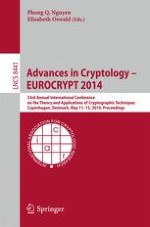This book constitutes the proceedings of the 33rd Annual International Conference on the Theory and Applications of Cryptographic Techniques, EUROCRYPT 2014, held in Copenhagen, Denmark, in May 2014. The 38 full papers included in this volume were carefully reviewed and selected from 197 submissions. They deal with public key cryptanalysis, identity-based encryption, key derivation and quantum computing, secret-key analysis and implementations, obfuscation and multi linear maps, authenticated encryption, symmetric encryption, multi-party encryption, side-channel attacks, signatures and public-key encryption, functional encryption, foundations and multi-party computation.
